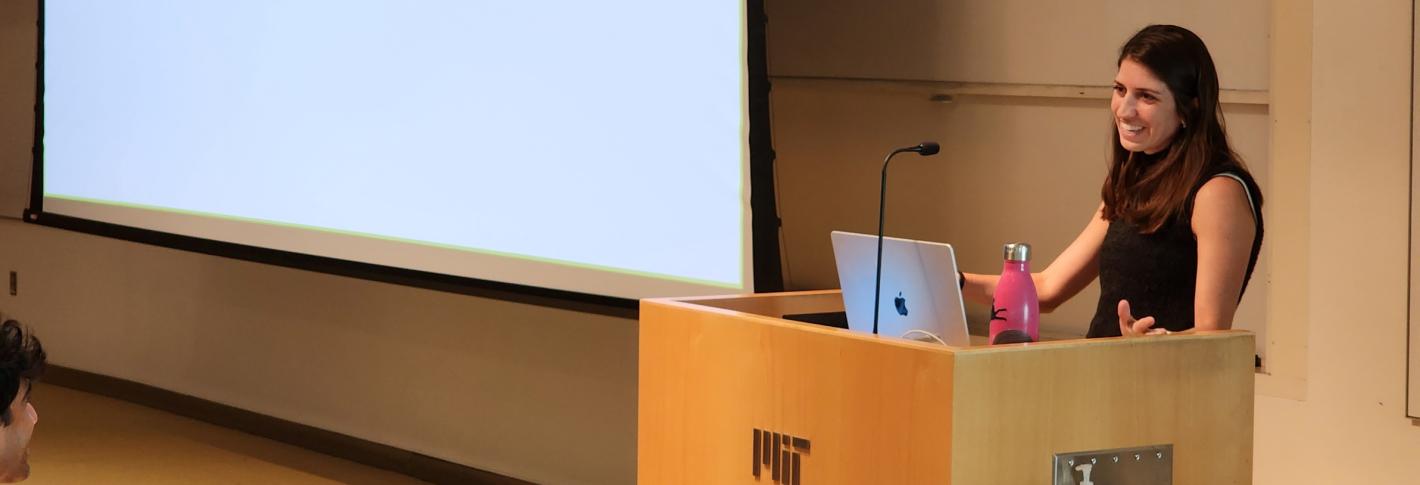
Picower Graduate Fellows are young scientists who have demonstrated outstanding scholarship, innovation and curiosity. They are pioneers with great potential to make profound impacts in brain science research at MIT and throughout their careers ahead. The Picower Graduate Fellows program provides the support to launch and sustain their training and research. As members of both their academic department and The Picower Institute, they join collaborative intellectual communities that provide many opportunities for mentoring and building research and professional skills.
Meet alumni of this program:
| Name | Lab | Research |
|---|---|---|
| Leyla Akay | Li-Huei Tsai | Akay's research focuses on glia and myelination in the context of Alzheimer's disease. She has concentrated on acquiring a better understanding of the effects of APOE4, the biggest genetic risk factor for late-onset Alzheimer's disease. on the human brain. Akay performs single-cell transcriptomics profiling of post-mortem human brains from APOE4 carriers compared with non-carriers and has revealed that APOE4 is associated with widespread gene expression changes across all human brain cell types. Notably, APOE4 alters cholesterol biosynthesis, trafficking, and localization in human and mouse oligodendrocytes (Blanchard et al., 2022). With insight into the importance of cholesterol in the brain, Leyla is pursuing strategies to target brain cholesterol. |
| Kendyll Burnell | Elly Nedivi |
Burnell's thesis focuses on structural synaptic plasticity, specifically the development of inhibitory synapses onto cortical pyramidal neurons. As a Picower graduate fellow, she has continued her work begun as a tech on the plasticity of inhibitory synapses onto pyramidal neurons and functionally characterizing the same neurons based on visual input. Using 3-color in vivo 2-photon microscopy, she observes excitatory and inhibitory synaptic plasticity events throughout development. |
| Gabi Drummond | Mriganka Sur | Drummond studied the spatiotemporal dynamics of norepinephrine release from the locus coeruleus during a learned behavior. Specifically, she is interested in locus coeruleus norepinephrine neurons' encoding of uncertainty and surprise and how these signals are distributed to brain-wide targets to facilitate two distinct components of a learned behavior, task execution, and task optimization. See her paper in Nature. |
| Preston Ge | Myriam Heiman | Preston studies mechanisms of early axonal degeneration in mouse models of neurodegenerative diseases such as Parkinson's. His thesis title was, "Subcellular Profiling of Dopaminergic Mitochondria: Adaptations to the Axonal Environment in Health and Disease" |
| Maxwell Heinrich | Mark Bear | Heinrich investigates the mechanisms and implications of hyperexcitable cortical circuitry in a mouse model of fragile X syndrome, the leading inherited cause of intellectual disability and autism spectrum disorders. We believe this work could lead to novel therapeutic strategies and biomarkers for treating this neurological disorder. |
| Minyoung Kim | Kwanghun Chung | Cellular morphology is strongly linked to distinct functional states in glia, so in-depth morphological analysis of the whole-brain volumetric data at high resolution offers immense potential for understanding their roles in brain development and disease. Kim developed computational tools for analyzing cellular morophology. Her thesis defense title was: "Mapping the Cellular Landscape of the Brain: A Scalable Approach to Comprehensive Microscopy Data Analysis" |
| Madison Leet | Mark Bear | Leet's project focuses on the mechanisms behind treatment methods that can promote improved vision in amblyopic mice. This research aims to ultimately facilitate the development of new and more effective approaches to amblyopia (lazy eye) therapy. |
| Josefina Correa Menéndez | Emery N. Brown | Correa Menéndez's thesis work entails devising a multi-level statistical modeling framework to analyze large-scale neural recordings. This framework will allow for studying neural dynamics at various spatio-temporal scales in a more principled manner, such as across brain regions, experimental sessions, and subjects. Her work aims to be computationally tractable, flexible, and applicable to datasets with different statistical properties. |
| Francis Reilly-Andujar | Mark Bear | Reilly-Andujar's research focuses on understanding the molecular and cellular processes involved in re-opening a window of enhanced neuronal plasticity in the visual cortex of the adult mouse. Understanding the processes that drive this increased plasticity will provide critical insights towards developing new therapies to treat amblyopia, a form of visual disability that affects ~3-5% of the US population. |
| Sara Simpson | Mark Bear | Sara worked to help elucidate how the brain stores memories, Simpson's research investigated the neural mechanisms, both at the cellular/synaptic and systems levels, necessary for consolidating visual recognition memory and its underlying neural plasticity. Her thesis title was: "Physiology and Plasticity of Primary Visual Cortex in Wild-Type and Fragile X Syndrome Model Mice." |
| Katya Tsimring | Mriganka Sur |
Tsimring's research focuses on neurons' functional development and plasticity in the mouse visual cortex during the critical period for ocular dominance plasticity. Specifically, she studies how dendritic spines on single neurons develop feature-selective responses and influence somatic responses by using two-photon calcium imaging and super-resolution microscopy to characterize their functional, structural, and molecular properties longitudinally. Her thesis title was: "Cellular and Synaptic Basis of Binocular Circuit Development in Mouse Visual Cortex" |
| Djuna von Maydell | Li-Huei Tsai |
Von Maydell’s research focuses on using single-cell transcriptomic analysis to investigate mechanisms underlying cognitive resilience. She also created the first publicly available single-cell gene expression dataset from postmortem human brain tissue of patients who are carriers of APOE4, the major Alzheimer’s disease risk gene. |
| Dae Hee Yun | Kwanghun Chung |
Yun worked to develop tools to enable better labeling and visualization of large brain volumes including epitope-preserving magnified analysis of proteome (eMAP) and electrophoretically driven fast labeling using affinity sweeping in hydrogel (eFLASH). His thesis title was: "Illuminating the Brain: Advances in High-Resolution, Multi-Scale Proteomic Labeling and Imaging." |

